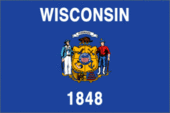Wisconsin's economy was originally based on farming (especially dairy), mining, and lumbering. In the 20th century, tourism became important, and many people living on former farms commuted to jobs elsewhere. Large-scale industrialization began in the late 19th century in the southeast of the state, with the city of Milwaukee as its major center. In recent decades, service industries, especially medicine and education, have become dominant. Wisconsin's landscape, largely shaped by the Wisconsin glaciation of the last Ice Age, makes the state popular for both tourism and many forms of outdoor recreation.
Since its founding, Wisconsin has been ethnically heterogeneous, with Yankees being among the first to arrive from New York and New England. They dominated the state's heavy industry, finance, politics and education. Large numbers of European immigrants followed them, including Germans, mostly between 1850 and 1900, Scandinavians (the largest group being Norwegian) and smaller groups of Belgians, Dutch, Swiss, Finns, Irish and others; in the 20th century, large numbers of Poles and descendants of slaves came, settling mainly in Milwaukee.
Today, 42.6% of the population is of German ancestry, making Wisconsin one of the most German-American states in the United States. Numerous ethnic festivals are held throughout Wisconsin to celebrate its heritage. Such festivals are world renowned, and include Festa Italiana, Bastille Days, Syttende Mai (Norwegian Constitution Day), Summerfest, Africal World Festival, Indian Summer, and many others.
Read more about Wisconsin:
State Government
Tourism
More tourism
